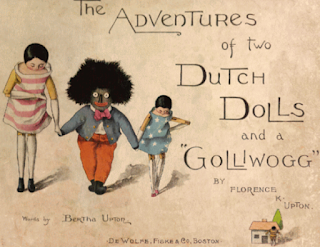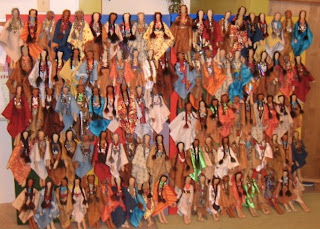
Image Courtesy of Wikipedia.com
As you all know I absolutely love dolls of all kinds, shapes, and sizes. However, while doing my research on the "
The History of Faceless Dolls" I read an article about
Penny Wooden Dolls, like the doll pictured above from
Wikipedia.org, and fell in love with them.
According to
Wikipedia.org, " Peg wooden dolls also known as Dutch dolls are a type of wooden doll from Germany and the Netherlands. They originated as simple lathe turned dolls from the Val Gardena in the Alps. These dolls were sold undressed. Young girls would then make their clothing from scraps of fabric."
"Other similarly constructed wooden dolls, using a jointing technique where the arms and/or legs are attached to the body with pegs, are some of the oldest surviving dolls, and were made worldwide. Sometimes a peg wooden doll's arms or legs are locked together by the jointing system, so if one arm is moved the other will move. An advanced form of peg joints is where the body pegs are "split" and attached separately allowing independent movement."
I was intrigued by the picture, shown
here, and wanted to know more. So, of course, I had to do some research. Here's what I found.
Page 146 of the Information Please Girls' Almanac by Alice Siegel said this about Pennywooden Dolls, "
These are English dolls carved out of wood. The joints are moveable and fastened by pegs. These are also know as dancing dolls."
My question was whether Peg Wooden dolls and Penny Wooden dolls were the same thing. I had to find out.
According to an article on
eHow.com entitled
Penny Wood Dolls History by Christy P., "
Penny wood dolls were known by a variety of names, including peg wooden dolls, penny woodens and wooden poppets. These dolls typically resembled wooden clothespins with simple peg joints."
So now we know they may be called Dutch dolls, peg wooden dolls, penny wooden dolls, pedlar dolls, and tuck comb dolls.
There was a
Grodnertal Wooden Peddler Doll that sold for thousands of dollars on the
Rubylane.com website. According to her description she was a spectacular example of a Grodnertal wooden pedlar doll.
There was a
Grödnertal Carved Wooden Doll, ca. 1820 on the
PBS.org WGBH Roadshow Archives website
here. This doll was appraised at several thousand dollars and was a tuck comb doll due to the little comb on the top of her head.
So now we know they may be called Dutch dolls, peg wooden dolls, penny wooden dolls, pedlar or peddler dolls, tuck comb dolls, Grodnertal Wooden Peddler, and Grodnertal carved wooden dolls.
The doll pictured above is from a wonderful post on the
Dolls from the Attic...Mis Muñecas blog, which I absolutely love, about
Grodner Tal, "Tuck Comb," Peg Wooden Dolls. This post is filled with information on these dolls as well as a ton of beautiful pictures. If you would like to read this post please
click here.
According to this post, "
From the home industry of the Groden Valley, Grodner Tal and South Tyrol, came the little peg wooden dolls. These are some of the oldest surviving dolls. Although the term peg-wooden refers to a jointing technique the term came to be synonymous with lathe turned dolls from these areas of the Alps. They were the inexpensive play dolls of generations in both Europe and America."
"Most of the dolls had combs carved into their heads-hence the term Tuck Combs. Their heads and bodies were lathe turned as one piece and had simple peg joints, but the larger dolls had ball joints and even swivel waists. They had elongated graceful proportions, nicely carved details, painted slippers and sometimes with wood pendant earrings."
"The hair is usually painted with curled bangs. Once painted and varnished they were ready for whatever adventures their little owners could conjure up. They are often referred to as German Tuck Combs, probably because they were sold in the German Nuremberg Toy Market, and sometimes incorrectly they are called Dutch dolls but this was a mispronunciation of the word Deutsch."
This was confirmed by a excerpt from the
Early North American Dollmaking: A Narrative History and Craft Instructions by Iris Sanderson Jones in 1976 which said,
"Long before the American Revolution, Grodner Tal doll salesmen carried great containers of toys and dolls into Italy and Spain. By the Civil War these dolls were known to English children as "Dutch dolls," probably the same distortion of the word "Deutsch," or "german," which occurred with the "Pennsylvaia Dutch" in the United States."
So, now we know they aren't actually Dutch dolls, but mispronounced Deutsch Dolls. This means they've been called Dutch aka Deutsch dolls, peg wooden dolls, penny wooden dolls, pedlar or peddler dolls, tuck comb dolls, Grodnertal Wooden Peddler, Grodnertal carved wooden dolls, Grodner Tal dolls, and Grodner Tal peg wood dolls.
According to the
Wood Dolls article by By Denise Van Patten, Doll Collecting Expert, on the
About.com website,
"Dates of Production Of Wood Dolls: As mentioned, wood dolls are known from ancient times. Italian creche figure examples are known as early as the 1500s (very rare) and English wood dolls from the late 1600s and early 1700s are quite rare. English wood dolls are more plentiful from the late 1700s and early 1800s, and German Grodner Tal and Peg Wood dolls are from the 1800s. A cottage industry created peg woodens well into the 20th century, and there are artists today still making wood dolls."
We learn from an exhibit on the
Illinois State Museum website that,
"Berechtesgaden, Grödner Tal, Oberammgergau--Peg-wooden Dolls - In several German-speaking areas of central Europe, the making of wooden dolls with peg jointing became an important part of the local economy. Most of these dolls were made in the mountainous area surrounding St. Ulrich, which was part of Austria until World War II, and is now part of Italy. In this area, called the Grödner Tal (Valley), wooden dolls and doll heads were being carved as early as the 1700s. By 1800, about 300 wood carvers in the Grödner Tal were making dolls, and sales agents took their work all over the world. The farm families living in the mountains spent their winters making dolls in a wide range of sizes from local wood, mostly pine. Most of the attention was put into the head, which required the most skill in carving and painting. The peg-jointed wooden bodies allowed for movement of the arms and legs. Peg-wooden dolls were also made in the forests of Thuringia (a northern area of Germany) and in the Berchtesgaden and Oberammergau Tyrolean area. Craftspeople making these dolls were also working in England, America, and China, but the quantities produced could not match those of the Grödner Tal. The Verlagers in Grödner Tal were important middlemen who organized production, purchased dolls from the carvers, stored them, and marketed the dolls for export. By 1873 almost the entire population of the Grödner Tal (3,500) were involved in the doll business, and one Verlager had thirty large showrooms containing millions of dolls."

There is an utterly adorable children's book published in 1895 entitled
"The Adventures of Two Dutch Dolls and a 'Golliwogg' by Florence K. Upton" that is visible on the
Gutenberg.org website that is so charming you have to read it. I loved the story and the adorable illustrations. If you would like to know more about the author, Florence K. Upton please
click here.
Image Courtesy of Theriaults.com
The
TWO GRODNERTAL WOODEN DOLLS,MOTHER AND SON,WITH ORIGINAL COSTUMES shown above were listed on the
Theriaults.com website. Here's what they had to say about them:
According to their description:
"TWO GRODNERTAL WOODEN DOLLS,MOTHER AND SON,WITH ORIGINAL COSTUMES - Lot Number: 78 - 9" (23 cm.) Each is all-wooden with one-piece head and torso,dowel-jointing at shoulders,elbows,hips and knees,the woman with black painted hair decorated with highly- stylized spit curls and tuck comb,elongated throat,and tiny centered painted features; and the boy with short black hair,suggestion of sideburns,painted features. Condition: good,unrestored,costumes are original albeit frail. Comments: Grodnertal,circa 1830,the dolls were featured in Ackerman's Dolls in Miniature. Value Points: both dolls wear their original stylized costumes."
How beautiful are they? Are you in love with penny wooden dolls, too?















































 Back in 2006 one of those articles was about "faceless" dolls of Gloria Larocque. She has created 100 or more "faceless" dolls based upon the Iroquois legend that warns young girls about the dangers of vanity.
Back in 2006 one of those articles was about "faceless" dolls of Gloria Larocque. She has created 100 or more "faceless" dolls based upon the Iroquois legend that warns young girls about the dangers of vanity.

 As far as Raggedy Ann is concerned, one of the legends surrounding her creation is that a little girl was rummaging around her Grandmother's attic and finds a faceless, battered old doll. She brings the doll into her fathers art studio and tells him all about finding it in the attic. He looks at his daughter and the faceless doll and decides to draw a whimsical face on it and then tells her to see if her Grandmother would sew two button eyes on. And so Raggedy Ann was born.
As far as Raggedy Ann is concerned, one of the legends surrounding her creation is that a little girl was rummaging around her Grandmother's attic and finds a faceless, battered old doll. She brings the doll into her fathers art studio and tells him all about finding it in the attic. He looks at his daughter and the faceless doll and decides to draw a whimsical face on it and then tells her to see if her Grandmother would sew two button eyes on. And so Raggedy Ann was born.